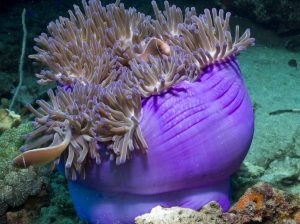Published February 21, 2016 | Diving, Fish, Nusa Lembongan
9 weird Facts of the Clownfish
Always wanted to know a little bit more about the clownfish or anemonefish? Have a look here what our Divemaster Candidate Flora has to say about that:
Fact 1 – 4 of the Clownfish
- The clownfish also known as the anemonefish, is a little fish related to the family called “Amphiprioninae”. They belong to the fish family with the name “Pomacentridae”. At this moment there are already been thirty species recognized. So “Nemo” as we know him from the Pixar movie has more family members then you think!
- Did you know that the clownfish also can have the color yellow, reddish or blackish with most of the time white bars or patche?!
- Some of the clownfish can grow up to 18 centimeters (7.1 in) and the smallest can be barely 10 centimeters (3.9 in). Although don’t forget that underwater an object is magnified by 33% so they appear bigger for a scuba diver.
- The clownfish lives in an anemone that forms protection (you can call it there house) and they prefer the bottom of the shallow water in sheltered reefs or in shallow lagoons. This is why not only scuba divers can see them, but also when you go out for some snorkeling.
Fact 5 – 8 of the Clownfish
- Did you know that there are NO clownfish in the Atlantic Ocean?!
- Did you know that clownfish sometimes eat a little bit of the tentacles of their host anemone?!
- A female clownfish can lay around 600 up till 1500 eggs depend on her size.
- The male clownfish is the protector of the eggs that will hatch after 6 till 10 days.
Last but not least Fact of the Clownfish
- In a group of clownfish the largest and most aggressive female is found at the top (yes girlpower underwater!) and they change sex without at some point in life?! This means that they are born male and when they get mature, they become females. If the female anemonefish is removed from the group, for example by death, one of the largest and most dominant males will become a female. The remaining males will move up a rank in the hierarchy.
More blogs from our PADI Divemaster Candidate Flora soon, so please stay tuned at Scuba Center Asia! If you like this blog, please share it, so Flora can see you liked it!




